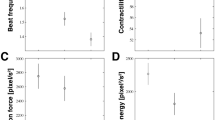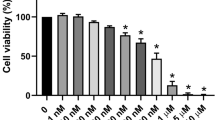Abstract
Trichloroethylene (TCE) is a halogenated hydrocarbon used as a solvent in industrial settings and in house-cleaning products. Exposure to TCE has been linked to increased risk for congenital heart malformations in both human and animal models. Previous studies showed TCE exposure reduced the expression and function of the ATP-dependent calcium pump, Serca2a, which is important for regulating calcium flux in myocytes and maintaining physiological cardiac function. In this study, we investigated whether TCE reduced Serca2a expression by altering the methylation status of its proximal promoter region. Low doses of TCE exposure (10 ppb) induced DNA hyper methylation in the Serca2 promoter region in cardiac myoblast cells and rat embryonic cardiac tissue. TCE exposure induced DNA methylation in a region of the Serca2 promoter which is the target for SP1 binding site essential for regulation of Serca2a transcriptional activity. Chromatin immunoprecipitation data confirmed that TCE exposure reduced the binding of SP1 to the Serca2 promoter region adjacent to the methylated CpG dimer. Finally, low-dose TCE exposure reduced the concentration of S-adenosyl-methionine in exposed cells and embryos. These cumulative data indicate that epigenetic mechanisms, including DNA methylation, may be important in mediating the teratogenic effects of TCE in embryonic heart.






Similar content being viewed by others
References
Agency for Toxic Substances and Disease Registry. (1998). Volatile Compounds in the Drinking Water and Adverse Pregnancy Outcomes. US Marine Corps Base, Camp Lejeune, North Carolina. PB98–156540. Springfield, VA: National Technical Information Service.
Bestor, T. H. (2000). The DNA methyltransferases of mammals. Human Molecular Genetics, 9, 2395–2402.
Bogdanović, O., & Veenstra, G. J. (2009). DNA methylation and methyl-CpG binding proteins: developmental requirements and function. Chromosoma, 118, 549–565.
Bove, F., Shim, Y., & Zeitz, P. (2002). Drinking water contaminants and adverse pregnancy outcomes: A review. Environmental Health Perspectives, 110(Suppl 1), 61–74.
Brady, M., Koban, M. U., Dellow, K. A., Yacoub, M., Boheler, K. R., & Fuller, S. J. (2003). Sp1 and Sp3 transcription factors are required for trans-activation of the human SERCA2 promoter in cardiomyocytes. Cardiovascular Research, 60, 347–354.
Burren, K. A., Savery, D., Massa, V., Kok, R. M., Scott, J. M., Blom, H. J., et al. (2008). Gene-environment interactions in the causation of neural tube defects: folate deficiency increases susceptibility conferred by loss of Pax3 function. Human Molecular Genetics, 17, 3675–3685.
Caldwell, J. C., & Keshava, N. (2006). Key issues in the modes of action and effects of trichloroethylene metabolites for liver and kidney tumorigenesis. Environmental Health Perspectives, 114, 1457–1463.
Caldwell, P. T., Manziello, A., Howard, J., Palbykin, B., Runyan, R. B., & Selmin, O. (2010). Gene expression profiling in the fetal cardiac tissue after folate and low-dose trichloroethylene exposure. Birth Defects Research Part A Clinical and Molecular Teratology, 88, 111–127.
Caldwell, P. T., Thorne, P. A., Johnson, P. D., Boitano, S., Runyan, R. B., & Selmin, O. (2008). Trichloroethylene disrupts cardiac gene expression and calcium homeostasis in rat myocytes. Toxicological Sciences, 104, 135–143.
Collier, J. M., Selmin, O., Johnson, P. D., & Runyan, R. B. (2003). Trichloroethylene effects on gene expression during cardiac development. Birth Defects Research Part A Clinical and Molecular Teratology, 67, 488–495.
Costello, J. F., & Plass, C. (2001). Methylation matters. Journal of Medical Genetics, 38, 285–303.
Dow, J. L., & Green, T. (2000). Trichloroethylene induced vitamin B (12) and folate deficiency leads to increased formic acid excretion in the rat. Toxicology, 146, 123–136.
Drake, V. J., Koprowski, S. L., Hu, N., Smith, S. M., & Lough, J. (2006). Cardiogenic effects of trichloroethylene and trichloroacetic acid following exposure during heart specification of avian development. Toxicological Sciences, 94, 53–62.
Drake, V. J., Koprowski, S. L., Lough, J., Hu, N., & Smith, S. M. (2006). Trichloroethylene exposure during cardiac valvuloseptal morphogenesis alters cushion formation and cardiac hemodynamics in the avian embryo. Environmental Health Perspectives, 114, 842–847.
Dugard, P. H. (2000). Effects of trichloroethylene (TCE) on an in vitro chick atrioventricular canal culture. Toxicological Sciences, 56, 437–438.
Garrido-Martin, E. M., Blanco, F. J., Langa, C., Fernandez, L. A., Vary, C. P., Lee, U. E., et al. (2010). Characterization of the human Activin-A receptor type II-like kinase 1 (ACVRL1) promoter and its regulation by Sp1. BMC molecular biology, 11, 51.
Gash, D. M., Rutland, K., Hudson, N. L., Sullivan, P. G., Bing, G., Cass, W. A., et al. (2008). Trichloroethylene: Parkinsonism and complex-1 mitochondrial neurotoxicity. Annals of Neurology, 63, 184–192.
Goldberg, S. J., Dawson, B. V., Johnson, P. D., Hoyme, H. E., & Ulreich, J. B. (1992). Cardiac teratogenicity of dichloroethylene in a chick model. Pediatric Research, 32, 23–26.
Goldman, S. M. (2010). Trichloroethylene and Parkinson’s disease: dissolving the puzzle. Expert Review of Neurotherapeutics, 10, 835–837.
Greene, A. L., Lalli, M. J., Ji, Y., Babu, G. J., Grupp, I., Sussman, M., et al. (2000). Overexpression of SERCA2b in the heart leads to an increase in sarcoplasmic reticulum calcium transport function and increased cardiac contractility. Journal of Biological Chemistry, 275, 24722–24727.
Hara, S., Arai, M., Tomaru, K., Doi, H., Koitabashi, N., Iso, T., et al. (2008). Prostaglandin F2α Inhibits SERCA2 Gene Transcription through an Induction of Egr-1 in Cultured Neonatal Rat Cardiac Myocytes. International Heart Journal, 49, 329–334.
Hardin, B. D., Kelman, B. J., & Brent, R. L. (2005). Trichloroethylene and dichloroethylene: A critical review of teratogenicity. Birth Defects Research Part A: Clinical and Molecular Teratology, 73, 931–955.
Hendricks, C. L., Ross, J. R., Pichersky, E., Noel, J. P., & Zhou, Z. S. (2004). An enzyme-coupled colorimetric assay for S-adenosylmethionine-dependent methyltransferases. Analytical Biochemistry, 326, 100–105.
Ifergan, I., & Assaraf, Y. G. (2008). Molecular mechanisms of adaptation to folate deficiency. Vitamins and Hormones, 79, 99–143.
Johnson, P. D., Goldberg, S. J., Mays, M. Z., & Dawson B. V. (2003). Threshold of trichloroethylene contamination in maternal drinking waters affecting fetal heart development in the rat. Environmental Health Perspectives, 111, 289–292.
Kangaspeska, S., Stride, B., Metivier, R., Polycarpou-Schwarz, M., Ibberson, D., Carmouche, R. P., et al. (2008). Transient cyclical methylation of promoter DNA. Nature, 452(7183), 112–115.
Kitazawa, S., Kitazawa, R., & Maeda, S. (1999). Transcriptional regulation of rat cyclin D1 gene bu CpG methylation status in promoter region. Journal of Biological Chemistry, 274, 28787–28793.
Lee, D. H., Jacobs, D. R., & Porat, M. (2009). Hypothesis: a unifying mechanism for nutrition and chemicals as lifelong modulators of DNA hypomethylation. Environmental Health Perspectives, 117, 1799–1802.
Lees-Murdock, D. J., & Walsh, C. P. (2008). DNA methylation reprogramming in the germ line. Advances in Experimental Medicine and Biology, 626, 1–15.
Makwana, O., King, N. M., Ahles, L., Selmin, O., Granzier, H. L., & Runyan, R. B. (2010). Exposure to low-dose trichloroethylene alters shear stress gene expression and function in the developing chick heart. Cardiovascular Toxicology, 10, 100–107.
Mercadier, J. J., Lompré, A. M., Duc, P., Boheler, K. R., Fraysse, J. B., Wisnewsky, C., et al. (1990). Altered sarcoplasmic reticulum Ca2(+)-ATPase gene expression in the human ventricle during end-stage heart failure. Journal of Clinical Investigation, 85, 305–309.
Papoutsis, A. J., Lamore, S. D., Wondrak, G. T., Selmin, O. I., Romagnolo, D. F., (2010). Resveratrol prevents epigenetic silencing of BRCA-1 by the aromatic hydrocarbon receptor in human breast cancer cells. Journal of Nutrition. [Epub ahead of print] PubMed PMID: 20631324.
Rufer, E. S., Hacker, T. A., Flentke, G. R., Drake, V. J., Brody, M. J., Lough, J., et al. (2010). Altered cardiac function and ventricular septal defect in avian embryos exposed to low-dose trichloroethylene. Toxicological Sciences, 113, 444–452.
Selmin, O. I., Thorne, P. A., Caldwell, P. T., & Taylor, M. R. (2008). Trichloroethylene and trichloroacetic acid regulate calcium signaling pathways in murine embryonal carcinoma cells p19. Cardiovascular Toxicology, 8, 47–56.
Tabrez, S., & Ahmad, M. (2009). Toxicity, biomarkers, genotoxicity, and carcinogenicity of trichloroethylene and its metabolites: a review. Journal of Environmental Science and Health. Part C, Environmental Carcinogenesis and Ecotoxicology Reviews, 27, 178–196.
Takahashi, T., Allen, P. D., & Izumo, S. (1992). Expression of A-, B-, and C-type natriuretic peptide genes in failing and developing human ventricles. Correlation with expression of the Ca(2 +)-ATPase gene. Circulation Research, 71, 9–17.
Tao, L., Ge, R., Xie, M., Kramer, P. M., & Pereira, M. A. (1999). Effect of trichloroethylene on DNA methylation and expression of early-intermediate protooncogenes in the liver of B6C3F1 mice. Journal of Biochemical and Molecular Toxicology, 13, 231–237.
Tao, L., Yang, S., Xie, M., Kramer, P. M., & Pereira, M. A. (2000). Effect of trichloroethylene and its metabolites, dichloroacetic acid and trichloroacetic acid, on the methylation and expression of c-Jun and c-Myc protooncogenes in mouse liver: prevention by methionine. Toxicological Sciences, 54, 399–407.
Yauck, J. S., Malloy, M. E., Blair, K., Simpson, P. M., & McCarver, D. G. (2004). Proximity of residence to trichloroethylene-emitting sites and increased risk of offspring congenital heart defects among older women. Birth Defects Research Part A Clinical and Molecular Teratology, 70, 808–814.
Ver Heyen, M., Heymans, S., Antoons, G., Reed, T., Periasamy, M., Awede, B., et al. (2001). Replacement of the muscle-specific sarcoplasmic reticulum Ca(2 +)-ATPase isoform SERCA2a by the nonmuscle SERCA2b homologue causes mild concentric hypertrophy and impairs contraction-relaxation of the heart. Circulation Research, 89, 838–846.
Wankerl, M., Boheler, K. R., Fiszman, M. Y., & Schwartz, K. (1996). Molecular cloning and analysis of the human cardiac sarco(endo)plasmic reticulum Ca(2+)-ATPase (SERCA2) gene promoter. Journal of Molecular and Cellular Cardiology, 28, 2139–2150.
Watson, R. E., & Goodman, J. I. (2002). Epigenetics and DNA methylation come of age in toxicology. Toxicological Sciences, 67, 11–16.
Zelko, I. N., Mueller, M. R., & Folz, R. J. (2010). CpG methylation attenuates Sp1 and Sp3 binding to the human extracellular superoxide dismutase promoter and regulates its cell-specific expression. Free Radical Biology and Medicine, 48, 895–904.
Zhu, W. G., Srinivasan, K., Dai, Z., Duan, W., Druhan, L. J., Ding, H., et al. (2003). Methylation of adjacent CpG sites affects Sp1/Sp3 binding and activity in the p21(Cip1) promoter. Molecular and Cellular Biology, 23, 4056–4065.
Acknowledgments
We would like to thank Patricia Nuzzo and Bryant Wong for their technical assistance. This study is funded by National Institutes of Health, SBRP Program; Grant Number: P42E04940. Arizona Biomedical Research Commission; Contract #0808; Grant Number 423610.
Author information
Authors and Affiliations
Corresponding author
Rights and permissions
About this article
Cite this article
Palbykin, B., Borg, J., Caldwell, P.T. et al. Trichloroethylene Induces Methylation of the Serca2 Promoter in H9c2 Cells and Embryonic Heart. Cardiovasc Toxicol 11, 204–214 (2011). https://doi.org/10.1007/s12012-011-9113-3
Published:
Issue Date:
DOI: https://doi.org/10.1007/s12012-011-9113-3




